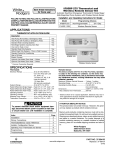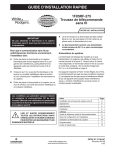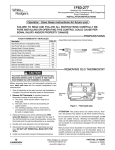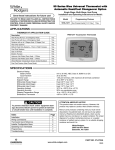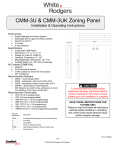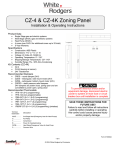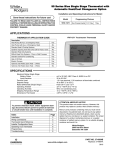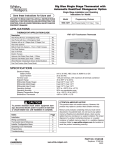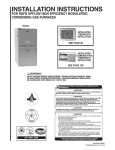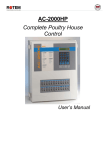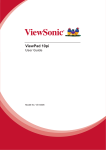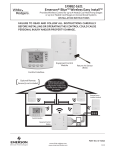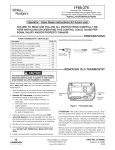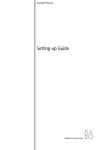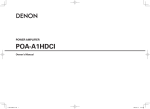Download White Rodgers 1F85RF-275 Installation guide
Transcript
QUICK INSTALLATION GUIDE Read Installer Notes before removing cover from Thermostat. 1F85RF-275 Wireless Remote Kit INSTALLER NOTES System Power IMPORTANT Do not apply power to the thermostat or wireless sensor until instructed to do so. For proper operation of the RF wireless communication, when installing: z Avoid locating thermostat or sensor near any wireless or noise generating devices, particularly radio devices that operate in the range of 418 to 428 MHz. z Be sure that there are no electrical wires, metal pipes or ductwork in the part of the wall chosen for thermostat or sensor location z Avoid locating the thermostat or sensor on a concrete wall, metal junction box or metal plate. z Thermostat antenna wire must be installed into the wall. Do not allow the antenna wire to be between the thermostat and the wall. z Thermostat must have uninterrupted 24VAC for proper communication. Any of the above can diminish or prevent proper RF communication for this kit. Be sure to perform a thorough checkout and confirm signal strength between thermostat and wireless sensor. FAILURE TO READ AND FOLLOW ALL INSTRUCTIONS CAREFULLY BEFORE INSTALLING OR OPERATING THIS CONTROL COULD CAUSE PERSONAL INJURY AND/OR PROPERTY DAMAGE. ! Thermostat is received from the factory for system power to be hardwired with a common wire connected to terminal C. If no common wire is available, the thermostat will use Power Stealing and must be configured. See Thermostat 24VAC Requirement on page 5. This device complies with Part 15 of the FCC Rules. Operation is subject to the following two conditions: (1) this device may not cause harmful interference, and (2) this device must accept any interference received, including interference that may cause undesired operation. Index Wireless Remote Kit Installation Applications Specifications Installation Wiring Connections Thermostat/Sensor Quick Reference Installer Configuration Menu Operating Your Thermostat and Sensor Programming Troubleshooting Page 2 4 4 5 6 8 10 14 17 18 PART NO. 37-6841E www.white-rodgers.com www.emersonclimate.com Replaces 37-6841C and D 1039 1 QUICK INSTALLATION GUIDE WIRELESS REMOTE KIT INSTALLATION System power must be turned off before beginning installation 1 Power Stealing – If the HVAC system does not provide enough power, we recommend connecting a 150 Ohm, 10 Watt resistor between terminals W and C of the furnace or Y and C on the air conditioner or both to increase the power provided. Mount thermostat Position and mount thermostat on wall following standard installation procedures. Questions on installation, see Guidelines for Thermostat/Sensor Locations and Mounting Thermostat and Sensor on page 5. When system power is turned on, if the display is blank, the thermostat is not receiving 24VAC. 3 Antenna Wire – When installing the thermostat, antenna wire must be installed into the wall for proper communication between the thermostat and the remote sensor. Provide battery power to remote sensor and check sensor transmission Now, remove Battery Tag from remote sensor to provide power. The remote sensor will transmit once every 10 seconds for one hour. Place the sensor on the thermostat for the best transmitting-receiving conditions. Thermostat Antenna Wire installed through wall Indicates sensor is transmitting signal Indicates sensor is receiving signal Signal strength 2 Connect wires to thermostat Connect wires following standard wiring procedures. Questions on wiring, see system diagrams on page 7. 24 VAC Requirement The thermostat must have 24VAC to operate. If a common wire is connected to terminal C, the system is providing 24VAC to the thermostat and the RC/PS switch (S7) should be in the RC position. (See Figure 1 on page 5) Proceed to step 3. If the thermostat does not have a common wire connected to terminal C, the RC/PS switch must be in the PS position to allow Power Stealing. 2 QUICK INSTALLATION GUIDE WIRELESS REMOTE KIT INSTALLATION 4 Confirm that thermostat is receiving 6 Once the ideal position is determined, mark mounting holes for the remote sensor. The batteries will have to be removed from the remote sensor to access the mounting hole under them. The thermostat receiving icon and the sensor transmitting icon will appear at the same time. The thermostat display will show SIGNAL and the strength of the signal, 3 bars high signal strength, 2 bars medium signal strength, and 1 bar low signal strength. The display will also show the temperature sensed by the remote sensor. During the one hour after remote sensor power-up, the thermostat should be receiving signals consistently (6 signals in one minute). 5 Position Remote Sensor at installation location Once communication has been confirmed, move remote sensor to permanent location. Do not mount remote sensor or drill holes to mount sensor yet. Have someone hold the remote sensor at the desired mounting location. Hold remote sensor on the left side to avoid interference with the transmitting antenna on the right side. Return to the thermostat and confirm that good communication with the thermostat can be established as described in step 5. Ideal consistency is 6 signals in 1 minute. Mount Remote Sensor After mounting the remote sensor, reinstall the batteries. The remote transmitter will begin transmitting again. Confirm that communication with the thermostat is still good as describe in step 5. 7 Complete Installation Perform operation check of thermostat with heating and cooling systems. Questions on thermostat operation, see Check Thermostat Operation on page 13. Check Remote Sensor operation as described in Remote Temperature Sensor Information on the Thermostat Display on page 14. In normal operation, the remote sensor will transmit when it senses a temperature change of 3/16 of a degree from the last transmission or after 10 minutes. The antenna icons will turn on briefly to indicate the sensor is transmitting and the thermostat is receiving. 3 Save these instructions for future use! FAILURE TO READ AND FOLLOW ALL INSTRUCTIONS CAREFULLY BEFORE INSTALLING OR OPERATING THIS CONTROL COULD CAUSE PERSONAL INJURY AND/OR PROPERTY DAMAGE. 1F85RF-275 Thermostat and Wireless Remote Sensor Kit Automatic Heat/Cool Changeover Thermostat for Single Stage/ Multi-Stage/Heat Pump Systems with Wireless Remote Sensor Installation and Operating Instructions for Model: Model Programming Choices 1F85RF-270 5/1/1 Day F145RF-1328 Non-Programmable Wireless Remote Sensor APPLICATIONS THERMOSTAT APPLICATION GUIDE Description Heat Pump (No Auxiliary or Emergency Heat) Heat Pump (with Auxiliary or Emergency Heat) Standard Heat & Cooling Systems Multi-Stage Systems requiring more than One Call for Heat or Cool Standard Heat Only Systems Millivolt Heat Only Systems – Floor or Wall Furnaces Standard Central Air Conditioning Gas or Oil Heat Electric Furnace Hydronic (Hot Water) Zone Heat – 2 Wires Hydronic (Hot Water) Zone Heat – 3 Wires Yes Yes Yes Yes Yes No Yes Yes Yes * Yes No 1F85RF-270 Thermostat F145RF-1328 Wireless Remote Sensor * Common Connection Required SPECIFICATIONS Thermostat: Remote Sensor: Electrical Ratings .......................... 20 to 30 VAC 50/60 Hz 0.2 to 0.6 Amps per Load (Y1, E/W1, G) 1.5 Amps (Y2, W2, O, B Load per terminal) 1.5 Amps Max (All terminals combined) Setpoint Range .............................. 45 to 90°F (7 to 32°C) Rated Differential (Single Stage) ... Heat 0.6° or 1.5°F, Cool 1.2°F Rated Differential (Multi-Stage) ..... Heat 0.6° or 1.5°F, Cool 1.2°F Rated Differential (Heat Pump) ..... Heat & Cool 0.75° or 1.2°F Operating Ambient ........................ 32 to +105°F (0 to +41°C) Operating Humidity ....................... 90% non-condensing max. Shipping Temp. Range .................. -4 to +150°F (-20 to +65°C) Thermostat Dimensions ............... 3-3/4"H x 6"W x 1-1/4"D This device complies with Part 15 of the FCC Rules, Operation is subject to the following two conditions: (1) this device may not cause harmful interference, and (2) this device must accept any interference received, including interference that may cause undesired operation. Maximum Wireless Remote Sensors .... 1 indoor, 1 outdoor Operating Range .................................... 45 to 90°F (7 to 32°C) Operating Humidity Range ..................... 0 to 90% RH (non-condensing) Dimensions ............................................. 2-5/8"H x 4-1/4"W x 7/8"D * Max. Distance from Thermostat .......... 200 feet ! * Distance shown is for a typical application. Distances may vary in some applications because obstacles that block the signal path may affect the strength of the signal. ATTENTION: MERCURY NOTICE This product does not contain mercury. However, this product may replace a product which contains mercury. WARNING Thermostat installation and all components of the control system shall conform to Class II circuits per the NEC code. Mercury and products containing mercury must not be discarded in household trash. Do not touch any spilled mercury. Wearing non-absorbent gloves, clean up any spilled mercury and place in a sealed container. For proper disposal of a product containing mercury or a sealed container of spilled mercury, place it in a suitable shipping container. Refer to www.white-rodgers.com for location to send product containing mercury. PART NO. 37-6841E www.white-rodgers.com Replaces 37-6841C and D 1039 INSTALLATION ELEC/GAS SWITCH ! CAUTION To prevent electrical shock and/or equipment damage, disconnect electric power to system at main fuse or circuit breaker box until power is required. Remove Old Thermostat Before disconnecting wires from the old thermostat, mark wires for terminal identification so the proper wiring connections will be made to the new thermostat. RC/PS SWITCH ANTENNA WIRE MOUNTING HOLE MOUNTING HOLE Figure 1 – Thermostat base ANTENNA WIRE REMOTE COMMUNICATION RECEIVER Guidelines for Thermostat/Sensor Locations Locate the thermostat/sensor about 5 ft. above floor level on an interior wall in an area that represents the average room temperature. Figure 2 – Back of thermostat base MOUNTING HOLE Do not mount directly on or near HVAC equipment or other sources of electrical noise. Avoid locations close to windows or near adjoining outside walls, doors leading outside, areas close to air registers or their direct air flow or areas with poor circulation like alcoves. Avoid locating the sensor on a concrete wall, junction box or metal plate. Make sure there are no electrical wires, metal, pipes or duct work in the part of the wall chosen for the sensor location. For proper RF wireless communication, the antenna wire MUST be installed into the wall. If the antenna wire is hanging between the wall and the thermostat the RF communication may not be reliable Antenna wire must be installed into the wall, it can not be between the thermostat and wall. Thermostat and indoor sensor are not approved for installation in unconditioned space. Thermostat 24 VAC Requirement The thermostat must have 24 VAC supplied for the receiver to operate. When the system wiring is connected, if a system common wire is connected to terminal C, the system is providing 24 VAC to the thermostat. The RC/PS switch (see Fig 1) must be in the RC position. If the thermostat does not have a common wire connected to terminal C, the thermostat can use Power Stealing to get the required 24 VAC. The RC/PS switch must be in the PS position. RC/PS Switch (Thermostat Power Option) RC/PS Switch Position Description RC For Hardwire Applications. Requires Common Wire from System Transformer to "C" Terminal on Thermostat PS For Power Stealing Applications. Use When Common from the System Transformer is not Available for Connection to the "C" Terminal on the Thermostat NOTE: If set to PS (Power Stealing), the thermostat "C" terminal must not have a wire connected. ANTENNA MOUNTING HOLE Figure 3 – Remote sensor base When the system is not providing enough power for the thermostat, the display will be bright when the system is not running and dim when the system is running. If the system is not providing enough power, we recommend connecting a 150 Ohm, 10 Watt resistor between terminals W and C of the furnace or Y and C of the air conditioner, or both, to increase the power provided. Mounting Thermostat and Sensor Do not remove battery tag to power the sensor with batteries until instructed to do so. The thermostat requires 24 volt system power to operate correctly. If the thermostat goes blank, system power is not reliable and will be corrected in the System Power section below. 1. Remove the packing material from the thermostat and sensor. 2. Pull the front cover of the thermostat straight off the base. Forcing or prying will cause damage to the control. 3. Using the thermostat base as a template, place on the selected wall locations and mark the location of all mounting holes (Figure 1), and the hole for the thermostat antenna wire illustrated in Figure 2. 4. Move base out of the way and drill the holes. If mounting holes drilled are too large and do not allow you to tighten base snugly, use the plastic screw anchors (provided) for secure mounting. 5. Make sure the remote communication receiver is plugged in properly to the thermostat and that the antenna wire is routed through the thermostat subbase as shown in Figure 2. 6. Insert antenna wire into the wall and position base into mounting position. 7. Fasten base loosely to wall, using two mounting screws. Place a level against bottom of base (leveling is for appearance only and will not affect sensor operation) and then tighten screws. 8. In the thermostat location, push excess wire into wall and plug hole with a fire resistant material (such as fiberglass insulation) to prevent drafts from affecting the thermostat operation. 5 INSTALLATION 9. Connect wires to thermostat terminals as required. Refer to wiring diagrams Fig. 4 thru 7 for proper wiring. 10.Apply system power and confirm that thermostat display is on and SYSTEM mode is OFF. Press SYSTEM button to OFF if necessary. 11.Enter the configuration as described in Thermostat Configuration Menu on page 10. Configure the thermostat for system operation. While in the configuration menu, enable the indoor remote wireless sensor (item 4) by changing OFF to ON. Confirming Communication of Remote Sensor to Thermostat Before finding a good location to mount the remote sensor, confirm that the thermostat is receiving the remote sensor signals consistently and at the best strength possible. Reliable Communication: While the sensor is in the Learn Mode, to be sure the thermostat and sensor have good communication. The thermostat receiving icon and the sensor transmitting icon will appear and turn off at about the same time. The thermostat will display SIGNAL and the strength of the signal. 3 bars indicates a strong signal and the most desirable, 2 bars indicates a medium strength signal and 1 bar indicates a weak signal which is acceptable if it can not be improved. The thermostat display will also show the temperature sensed by the remote. The thermostat should receive 6 signals in 1 minute and the signal strength should be 3 bars if possible. 1. Remove the battery tag from only the remote sensor. The battery tag must still be in the thermostat. The remote sensor will begin transmitting a signal once every 10 seconds for one hour. 2. Place the remote sensor on the thermostat and check that the thermostat is receiving signals from the sensor. Confirm that the sensor and thermostat have reliable communication as described above in Reliable Communication. 3. Move the remote sensor to the room where it is to be installed. Do not mark a mounting location or drill holes yet. 4. Have someone hold the remote sensor at the location selected for the remote sensor. Hold the remote sensor on the left side to avoid interference with the transmitting antenna on the right side of the sensor. 6. Return to the sensor and confirm that reliable communication with the sensor can be established again as described in Reliable Communication. Have the sensor moved, if necessary to improve the signal strength if it is not a consistent signal with signal strength of 3 bars. 7. Once the ideal position for the sensor is determined, mark mounting holes using the sensor base as a template (Figure 3). The batteries will have to be removed to access a mounting under them. 8. After the sensor is firmly attached to the wall and the batteries are reinstalled, the remote sensor will begin transmitting again for one hour. Return to the thermostat and once again confirm that communication is still good as described in Reliable Communication. Battery Location The sensor requires 2 "AAA" alkaline batteries. Batteries are included at the factory with a battery tag to prevent power drainage. The battery tag must be removed to engage the batteries. For best results, replace batteries once a year with new premium brand alkaline batteries such as Duracell® or Energizer®. Electric/Gas Switch (Fan Option) The ELEC/GAS switch on the thermostat (Fig. 1) is factory set to the ELEC position. In this position, the thermostat will power the circulator fan on a call for heat. Electric heat systems may require the switch to be in the ELEC position. If your system does not require that the thermostat power the circulator fan, this switch should be set to the GAS position. Typically, gas and oil heating systems do not require the thermostat to power the circulator fan during a call for heat. If your heat is gas or oil, the switch should be set to the GAS position. When the thermostat is configured for Heat Pump, the thermostat will always power the circulator fan on a call for heat in the HEAT mode. The ELEC/GAS switch must be set to match the type of Auxiliary heat your system uses for proper operation in the EMERgency mode. WIRING CONNECTIONS Typical wiring diagrams are provided below for the following systems: Single Stage Heat/Cool systems Multi-Stage Heat/Cool systems (No Heat Pump) Heat Pump system, one compressor or one speed compressor with Aux. Heat Heat Pump systems, two compressors or two speed compressor with Aux. Heat Refer to the equipment manufacturers instructions for specific wiring information. After completing the connections configure the thermostat in the Installer Configuration Menu to match your system type. 6 WIRING CONNECTIONS Figure 4 – Single Stage (No Heat Pump) Terminal Outputs R *C Y1 W2 Y2 O B L Energized in Cool Mode (Changeover Valve or Damper) Energized in Heat, Off Mode (Changeover Valve or Damper) Fault Indicator for Heat Pump Systems with Malfunction Switch G E/W1 System Single Stage (SS1) 24 Volt (Hot) Blower/ Circulator Fan Energized on Call for Cool or Fan, Energized on Call for Heat if Elect/Gas Switch Set to Electric 24 Volt Heat (Common) Cool Mode No Output No Output Mode 1st Stage Optional 1st Stage Connection (Compressor) (Heater) NEUTRAL 120VAC 24VAC HOT CLASS II TRANSFORMER Figure 5 – Multi-Stage (No Heat Pump) Terminal Outputs R Y1 *C W2 Y2 G E/W1 O B L Energized in Cool Mode (Changeover Valve or Damper) Energized in Heat, Off Mode (Changeover Valve or Damper) Fault Indicator for Heat Pump Systems with Malfunction Switch System Multi-Stage (MS2) 24 Volt 24 Volt (Common) Cool Mode Heat Cool Mode Heat (Hot) Mode 2nd Stage Mode 1st Stage Optional Connection (Compressor 1) (Compressor 2) 2nd Stage 1st Stage Blower/ Circulator Fan Energized on Call for Cool or Fan, Energized on Call for Heat if Elect/Gas Switch Set to Electric NEUTRAL 120VAC 24VAC HOT Figure 6 – Heat Pump Terminal Outputs R *C W2 Y2 Y1 CLASS II TRANSFORMER O B L Energized in Cool Mode (Changeover Valve) Energized in Heat, Off, Emergency Mode (Changeover Valve) Fault Indicator for Heat Pump Systems with Malfunction Switch G E/W1 System Heat Mode 2nd Stage. 24 Volt Emergency 24 Volt (Common) Heat ModeMode 2nd Stage Emergency (Hot) 1st Stage Optional Mode Connection Cool Mode- Heat Mode- Heat Heat Pump 2 1st Stage Mode 1st Stage (HP2) 2nd Stage 3rd Stage. (Compressor 1) Two Cool Mode- Emergency Compressor 2nd Stage Mode 2nd or Two Speed (Compressor 2) Stage Compressor Heat Pump 1 (HP1) Single Compressor Heat Pump No Output Blower/ Circulator Fan Energized on Call for Heat/Cool or Fan, Note: Set Elect/Gas switch for Emergency Mode Heat Type NEUTRAL 120VAC 24VAC HOT CLASS II TRANSFORMER Figure 7 – Heat Pump Terminal Outputs - Two Transformer with no Safety Circuits R *C Y1 Y2 W2 E/W1 G O B L Energized in Cool Mode (Changeover Valve) Energized in Heat, Off, Emergency Mode (Changeover Valve) Fault Indicator for Heat Pump Systems with Malfunction Switch System Heat Blower/ Mode Circulator 2nd Stage. Fan Energized 24 Volt Emergency on Call for 24 Volt (Common) Heat ModeMode 2nd Heat/Cool Stage Emergency (Hot) 1st Stage Optional or Fan, Mode Connection Cool Mode- Heat Mode- Heat Heat Pump 2 1st Stage Note: Set 1st Stage (HP2) 2nd Stage Mode 3rd Stage. Elect/Gas (Compressor 1) Two Cool Mode- Emergency switch for Compressor 2nd Stage Mode 2nd Emergency or Two Speed (Compressor 2) Stage Mode Heat Type Compressor Heat Pump 1 (HP1) Single Compressor Heat Pump No Output HEAT COOL NEUTRAL 120VAC 24VAC 120VAC NEUTRAL 24VAC HOT HOT CUT AND TAPE OFF TWO COMMONS MUST BE JUMPERED TOGETHER CLASS II TRANSFORMER * The RC/PS switch shown in Figure 1 configures the thermostat for Hardwire or Power Stealing. The factory setting is RC (Hardwire) and requires a Common connection from the system transformer to the "C" terminal on the thermostat. If no common wire is available for the thermostat "C" terminal, move the RC/PS switch to PS (Power Stealing). NOTE: If set to PS (Power Stealing), the thermostat "C" terminal must not have a wire connected. 7 THERMOSTAT/REMOTE SENSOR QUICK REFERENCE Before operating the thermostat, familiarize yourself with the display and button functions. Both thermostat and remote sensor consist of two parts: the cover and the base. To remove a cover, pull it straight out from the base. To replace a cover, line it up with the base and press until the cover snaps into place on the base. 2 The Thermostat Buttons and Switches and Display 1 Raises and lowers the temperature setting. 2 Light flashes every 20 seconds indicating acceptable signal reception from indoor or outdoor remote sensor. 3 Buttons for setting time (Time), programming (Prgm), running program (Run) and bypassing program to hold a constant temperature (Hold). 4 4 6 5 7 SYSTEM button (COOL, AUTO, HEAT, OFF, EMER heat pump systems only). 8 5 FAN switch (ON, AUTO). 9 6 Displays the active temperature sensor (outside, remote, local) and its sensed temperature if more than one sensor is enabled. 10 7 Displays ( ) when in keypad lockout mode. 8 Indicates day of the week. 9 Indicates the thermostat mode information: "HOLD" alternates with the system mode (see item 12) if the HOLD button is pressed to bypass the program and maintain a constant temperature. 10 Displays currently programmed set temperature (blank when SYSTEM is OFF). 11 Alternately displays the current time and the temperature average of sensors (thermostat [local] and/or indoor remote) turned on. 12 13 8 "HEAT" is displayed when set to heating, "COOL" is displayed when set to cooling, "AUTO" is displayed when set for automatic changeover between heating and cooling. When "AUTO" is displayed, the currently active mode (Heat or Cool) will also display. "EMER" is displayed flashing (heat pump systems only) when the thermostat is set to the Emergency Mode. Emergency is used to bypass the heat pump and use only the back-up heating system. "FLTR" is displayed as a reminder to change or clean the air filter after system has run for the programmed filter time period. Stage 1 & 2 indicator. "STG 1" indicates when the first stage heat or cool is energized. "STG + 2" indicates when the second stage heat or cool is energized. "+2" blinking indicates Auxiliary Heat stages are energized on Heat Pump Systems. 12 11 14 13 15 16 17 Figure 8 – Thermostat display, buttons and switches 14 Displays "LR" when the limited range feature is activated. Limited range limits the temperature the thermostat can be set to. 15 Indicates the system is sending a fault signal to the thermostat "L" terminal. This does not indicate a fault in the thermostat. 16 Antenna will display for a few seconds when the remote or outdoor transmitted signal is received. 17 Indicates the current signal strength level of the remote temperature system. Signal strength level is low (one bar on), medium (two bars on) or high (three bars on). The remote will operate with 1 bar showing. THERMOSTAT/SENSOR QUICK REFERENCE The Sensor Buttons and Display 1 Raises the Comfort adjust graph setting. 2 Lowers the Comfort adjust graph setting. 3 Sensed temperature from –40 to 140°F with °F and °C Figure 9 – Remote Sensor display and buttons 1 2 indicator 4 Channel identification A B C O indicator 5 9 bar comfort adjust graph with H (hotter) and C (cooler) 6 Transmission occurrence indicator 7 Keypad lockout indicator 8 Calibrate temperature offset indicator 9 Learn mode activated indicator 10 Low battery indicator 11 Temperature offset used when hold time is active 12 Displays PWR and on to indicate normal operation with display turned OFF Normal Operation 3 o 6 4 A 5 Configuration Items 3 5 o 6 H 7 LOCK ABCO CALIB 4 8 PWR HLD BATT LEARN C 5 5 12 11 10 9 9 THERMOSTAT CONFIGURATION MENU INSTALLER/CONFIGURATION MENU Press the System button until OFF is displayed, then press the Press or to select and simultaneously Step Press Button(s) Displayed (Factory Default) 1 System MS2 SS1, HP2, HP1 Selects Single stage, Multi-stage, or Heat Pump (Single stage or 2-stage) system configuration 2 System LER (OFF) LER (ON) Selects learn mode OFF or ON 3 System OUTSIDE (OFF) OUTSIDE (ON) Selects OUTSIDE sensor OFF or ON 4 System REMOTE (ON) REMOTE (OFF) Selects REMOTE (indoor) sensor OFF or ON 5 System LOCAL (ON) LOCAL (OFF) Selects LOCAL sensor ON or OFF 6 System CH (0) 1 to 9 Select Receiver frequency offset 7 System PRG 4 PRG 0, PRG 2 Selects Programmable Periods 8 System EMR (ON) EMR (OFF) Selects Energy Management Recovery OFF or ON 9 System CR HEAT COOL (FA) SL Selects Fast or Slow cycle selection 10 System CL (OFF) CL (ON) Selects Compressor Lockout CL OFF or ON 11 System CdL (ON) CdL (OFF) Selects Backlight Display ON or OFF 12 System FA HEAT COOL (ON) FA HEAT COOL (OFF) Selects Fast Second Stage ON or OFF 13 System 0 FLTR 0–1950 (increments of 50) Selects filter replacement run time.0 =Disabled 14 System 0F (Room Temperature) 4 LO to 4 HI Selects Temperature Display Adjustment 4 LO 4 HI 15 System 4:00 HOLD 0:00 to 8:00 (Increments of 15 minutes) Selects Temporary Program Override Time 0:00 =Disabled 16 System F C For C selection Selects temperature display as F° or C° 17 System LR HEAT (90) LR 62 to LR 89 Selects Limited HEAT range 18 System LR COOL (45) LR 46 to LR 82 Selects Limited COOL range 19 System CA (OFF) CA (ON) Selects Comfort Alert Lock 20 System OFF LOCK ON LOCK Selects Button pad Lockout 0 00 LOCK 001 to 999 Selects Buttonpad lockout combination number Press System to set code 21 Run Returns to the OFF mode The configuration menu allows you to set certain thermostat operating characteristics to your system or personal requirements. Set SYSTEM button to OFF, then simultaneously press and to enter configuration menu. The display will show the first item in the configuration menu. The configuration menu table summarizes the configuration options. An explanation of each option follows. Press SYSTEM to change to the next menu item. To exit the menu and return to the program operation, press RUN. If no keys are pressed within fifteen minutes, the thermostat will revert to normal operation. 1) Single Stage, Multi-stage or Heat Pump Configuration This menu item requires you configure the thermostat to match your system. Choose your system option from the table below: System Type Select Option Single Stage Heat/Cool systems SS1 Multi-Stage Heat/Cool systems (No Heat Pump) MS2 Heat Pump system, 1 compressor or 1 speed compressor HP1 Heat Pump systems, 2 compressors or 2 speed compressor HP2 The thermostat is factory defaulted to MS2. To select a different option, press the or key to scroll through the choices. 10 Comments 2) Select Learn Mode On or Off – Selecting LER On enables the learn mode of the thermostat receiver. Your thermostat is configured at the factory to recognize the remote sensor shipped with it. The Learn Mode Option is used only when required as described in Learn Mode Option. 3) Selects OUTSIDE sensor OFF or ON – Selecting OUTSIDE ON enables the thermostat to read a wireless outdoor temperature sensor that has been configured for Sensor O in the Learn Mode. This allows the thermostat to display the outdoor temperature reading. 4) Selects REMOTE sensor OFF or ON – Selecting REMOTE ON allows the thermostat to sense an indoor remote sensor that has been set-up the Learn mode. The maximum number of Indoor Remote Sensors is 1 configured to sensor A, B or C. 5) Selects LOCAL sensor ON or OFF – Appears if Remote is set to ON. Selecting LOCAL ON allows the thermostat to use the onboard temperature sensor exclusively or for averaging with the remote sensor readings. To control temperature using only the indoor or buttons remote sensor temperature(s), use the to select LOCAL OFF. 6) Select Receiver frequency offset – Appears if Remote is set to ON. This option allows you to select a different channel than the factory default for communication between the thermostat and remote sensor. Note: If a THERMOSTAT CONFIGURATION MENU different channel is selected on the thermostat it must also be changed to the same setting on the remote. This is only used in areas where there are other wireless devices or electronic equipment that interfere with the default frequency of the thermostat/remote sensor communication. 7) Programmable Periods – This control can be configured for 4, 2 or 0 programmable periods. The display indicates "PRG 4" in the display as default. The programmable periods can be changed to 2 or 0 by pressing the or keys. With "PRG 0" selected for non-programmable, SYSTEM key selection will skip EMR (item 8) and temporary program override (item 15). 8) Select Energy Management Recovery OFF or ON – Energy Management Recovery (EMR) causes the thermostat to start heating or cooling early to make the building temperature reach the program setpoint at the time you specify. Heating will start 5 minutes early for every 1° of temperature required to reach setpoint. Example: You select EMR and have your heating programmed to 65° at night and 70° at 7 AM. If the building temperature is 65° the difference between 65° and 70° is 5°. Allowing 5 minutes per degree the thermostat setpoint will change to 70° at 6:35 AM. Cooling allows more time per degree because it takes longer to reach temperature. 9) Fast or Slow Cycle Selection – The factory default setting is fast cycle, which cycles 1st stage at approximately 1.2°F and 2nd stage 0.75°F. If you prefer slow cycle, press the temperature key to change to SL. The 1st stage and 2nd stage would be 1.5°F and 1.2°F respectively. 10)Select Compressor Lockout CL OFF or ON – Selecting CL ON will cause the thermostat to wait 5 minutes before turning on the compressor if the heating and cooling system loses power. It will also wait 5 minutes minimum between cooling and heating cycles. This is intended to help protect the compressor from short cycling. Some newer compressors already have a time delay built in and do not require this feature. Your compressor manufacturer can tell you if the lockout feature is already present in their system. When the thermostat compressor time delay occurs it will flash the setpoint for about five minutes. 11)Select Backlight Display – The display backlight improves display contrast in low lighting conditions. When the "C" terminal is powered, selecting backlight CdL ON will keep the light on continuously. Select backlight OFF will keep the light on momentarily after any key is pressed. When the "C" terminal is not powered, the light will be on momentarily after any key is pressed no matter the backlight is selected ON or OFF. 12)Select Fast Second Stage On or OFF – For Heat: During normal operation if the setpoint temperature is manually raised by 3°F or more above the actual button, and the fast second temperature with the stage feature is enabled, FA ON, the second stage will energize immediately. For Cool: During normal operation if the setpoint temperature is manually lowered by 3°F or more below the button, and the fast actual temperature with the second stage feature is enabled, FA ON, the second stage will energize immediately. 13)Select filter replacement run time – The thermostat will display "FLTR" after a set time of operation. This is a reminder to change or clean your air filter. This time can be set from 0 to 1950 hours in 50 hour increments. A selection of 0 will cancel this feature. When "FLTR" is displayed, you can clear it by pressing HOLD and RUN at the same time. This resets the timer and starts counting the hours until the next filter change. Contact your system manufacturer for a specific replacement/maintenance interval. 14) Select Temperature Display Adjustment 4 LO to 4 HI – Allows you to adjust the room temperature display up to 4° higher or lower. Your thermostat was accurately calibrated at the factory but you have the option to change the display temperature to match your previous thermostat. The current or adjusted room temperature will be displayed on the left side of the display. 15)Select Temporary Program Override Time – The thermostat can hold any temperature you set it to for the amount of time you select on this option. Your choices are 0:00 to 8:00 hours in 15 minute increments. 0:00 means disable. Example: 1. You have selected 3:00 hours for the Temporary Program Override time period. 2. With the thermostat set to Heat or Cool, press HOLD for approximately 5 seconds until "HOLD time 3:00" (indicating 3 hours) appears as a setting reminder. 3. After releasing the button, "HOLD" on the display will blink. or to set the temperature to your prefer 4. Use ence. The thermostat will maintain this temperature setting for 3 hours with "HOLD" blinking to remind you it is in Temporary Hold. After 3 hours, the thermostat will go back to the program temperature and "HOLD" will no longer blink or display. 16)Select F° or C° Readout – Changes the display readout to Celsius or Fahrenheit as required. 17)Limited Heat Range – This feature provides a maximum setpoint temperature for heat. The default setting is 90°F. It can be changed between 62°F and 89°F by pressing the or key. 18)Limited Cool Range – This feature provides a minimum setpoint temperature for cool. The default setting is 45°F. It can be changed between 46°F and 82°F by pressing the or key. 19)Comfort Alert – This feature is available in Passive mode on this thermostat. If a Comfort Alert module is connected, the thermostat will receive and flash the fault codes from the Comfort Alert module. 20 & 21) Keypad Lockout – This menu selection will and are used to toggle display lock ( ) icon. The the function and display the lock icon and OFF (keypad not locked out, default) indicating in the time digits to the lock icon and ON (keypad locked out). When the keypad lockout function is enabled (ON), and the SYSTEM button is pressed again, the display will indicate the number 000 and (default, still disabled) in the time digits. The are used to set the combination number from 0 to 999. If a combination of 000 is selected and the SYSTEM button is pressed, the menu will be exited and keypad will not be locked. If 1 to 999 is selected and the SYSTEM button is pressed again, the combination is locked into non-volatile memory and the menu is exited. The lock icon (to designate keypad locked with a valid combination) will display when the menu is exited. The SYSTEM button will operate for 10 seconds after the menu mode is exited to allow the user to change the mode from OFF to the desired system mode. While the keypad is locked out, a simultaneous press of and will enter the menu item from any mode instead of only OFF mode. When the menu is entered with the keypad lockout feature enabled, the first menu item or keys displayed is the combination code 0. The are used to set the combination unlock number from 0 to 999. If the unlock number matches exactly with the combination lock number stored in memory when the SYSTEM button is pressed, the keypad is unlocked and the lock icon is removed. If the unlock number does not match when the SYSTEM button is pressed, menu is exited and the keypad remains disabled. To reset the combination code and unlock the keypad if the code is forgotten, see troubleshooting section, page 20. 11 REMOTE SENSOR CONFIGURATION MENU The configuration menus allow you to set certain remote sensor operating characteristics to your system or personal requirements. Two configuration menus are available, User Configuration and Installer Configuration. User Configuration Menu and keys at the same time and release to enter the User menu. To scroll through the menu Momentarily press items press the and keys at the same time. To change the item option press or . To exit the menu scroll through all menu items. If no buttons are pushed for 3 minutes, the control will also return to normal operation. The User Configuration Menu table summarizes the configuration options. An explanation of each option follows. User configuration menu Step 1 Press button(s) to scroll menu and 2 and 3 and 4 and 5 and 6 and 7 and Displayed (factory default) LOCK (OF) HLD (4h) CALIB (Sensed Temperature) dF (on) dL (on) o F (Sensed Temperature) _____ Press or to change option on Comments 1 to 8 hrs in 1 hour increments 1-4 bars (1°-4°) C to 1-4 bars (1°-4°) H OF Select temporary adjust thermostat setpoint hold time Select temperature display adjustment higher or lower Select display temperature OFF or ON OF Select display backlight OFF or ON o Select temperature display to F or C C _____ 1) Select keypad lockout OFF or ON – Selecting LOCK ON will cause the keypad to be locked in the normal operation mode. This prevents the and from being used to adjust temperature. The display will indicate "LOCK" when the keypad is locked. If LOCK OF and keys can still be used. is selected, the When the keypad is locked, the and keys can still be pressed at the same time to enter the configuration menu. 2) Select temporary adjust thermostat setpoint hold time – Selects the length of time for the temporary thermostat setpoint adjustment. Hold time default is 4 hours and can be set from 1 to 8 hours in 1 hour increments. 3) Select temperature display adjustment higher or lower – allows you to adjust the room temperature display 1° to 4° higher or lower. Your sensor was accurately calibrated at the factory but you have the option to 12 Select keypad lockout OFF or ON Exits user menu and returns to normal operation change the display temperature to match your previous sensor or thermostat. 4) Select display temperature OFF or ON – Selecting OF allows you to disable displaying the sensed temperature. Instead of the temperature, the sensor will display "PWR" with the word on to indicate normal operation. With display OFF the Transmitting icon will not appear. 5) Select display backlight OFF or ON -. The display backlight improves display contrast in low lighting conditions. Selecting dL on will keep the light on for a short period of time after any key is pressed. Selecting OF will keep the light off. 6) Select temperature display to oF or oC - Changes the display readout to Celsius or Fahrenheit as required. REMOTE SENSOR CONFIGURATION MENU Installer Configuration Menu Your thermostat is configured at the factory to recognize the remote sensor it is shipped with as indoor sensor A. The Installer Configuration Menu is used only when adding or replacing a remote sensor or selecting a frequency offset. and buttons at the same time for a minimum of five seconds then release to enter the Installer menu. To Press scroll through the menu items, momentarily press the and buttons at the same time. To change the item option, press or . To exit the menu scroll through all menu items. If no buttons are pushed for 3 minutes, the control will return to normal operation. The Installer Configuration Menu table summarizes the configuration options. An explanation of each option follows. Installer Configuration Menu Step 1 Press button(s) to scroll menu and 2 and 3 and 4 and Displayed (factory default) LEARN (OF) Press or to change options on CH (A) C (0) _____ B, C, O Select learn mode OFF or ON (will be ON for one hour after sensor power-up) Select sensor identification as A, B, C or O 1 through 9 Select transmitter frequency offset _____ Exit installer menu and return to normal operation 1) Select learn mode OFF or ON – Selecting LEARN on enables the sensors learning mode. In the learning mode the sensor will transmit identification information once every 10 seconds for a period of 10 minutes. The LEARN icon will be displayed during the learning mode. The Transmitting icon will be displayed for a short period of time with each transmission. See Learn Mode Option. If the display is selected OFF, the Transmit icon and Learn icon will not appear. Learn mode is ON at powerup for one hour. 2) Select sensor identification from A to O – For multiple sensors systems, each sensor must have a designated identification. The thermostat can operate with one indoor sensor and one outdoor sensor. For indoor sensors you may select A, B or C. For outdoor sensor you must select O. Comments 3) Select transmitter frequency offset – The sensor’s transmitter operates on 418MHz radio frequency by default. Interference may occur if another device or equipment operates on the same frequency. The interference may degrade the communications between the sensor and the thermostat. To avoid interference, you may select a different radio frequency for your sensor. This menu item allows you to select a radio frequency offset from 1 to 9MHz from the base frequency. For example; if you selected an offset of 4, the transmitter radio frequency will be 418MHz + 4MHz = 422MHz. Note that the sensor’s transmitter and the thermostat’s receiver must operate on the same frequency to communicate. To change thermostat’s receiver frequency please refer to Thermostat Configuration Menu (Item 6). OPERATING YOUR THERMOSTAT AND REMOTE SENSOR Check Thermostat Operation NOTE To prevent static discharge problems, touch side of thermostat to release static build-up before touching any keys. If at any time during testing your system does not operate properly, contact a qualified service person. Fan Operation If your system does not have a G terminal connection, skip to Heating System. 1. Turn on power to system. 2. Move FAN switch to ON position. The blower should begin to operate. 3. Move FAN switch to AUTO position. The blower should stop immediately. Heating System 1. Press SYSTEM button to select HEAT. If the auxiliary heating system has a standing pilot, be sure to light it. to adjust thermostat setting to 1° above room 2. Press temperature. The heat pump system should begin to operate. The display should show "STG1". However, if the system configuration is set to HP1 or HP2 and setpoint temperature display is flashing, the 5 minute compressor lockout feature is operating (see Configuration menu, item 10). 3. Adjust temperature setting to 3° above room temperature. If your system configuration is set at MS2, HP2 or HP1, the auxiliary heat system should begin to operate and the display will show "STG 1+2". to adjust the thermostat below room tempera4. Press ture. The heating system should stop operating. ! CAUTION Do not allow the compressor to run unless the compressor oil heaters have been operational for 6 hours and the system has not been operational for at least 5 minutes. 13 OPERATING YOUR THERMOSTAT AND REMOTE SENSOR Emergency System Automatic System Changeover EMER bypasses the Heat Pump to use the heat source wired to terminal E/W1 on the thermostat. EMER is typically used when compressor operation is not desired, or you prefer back-up heat only. 1. Press SYSTEM button to select EMER. "EMER" will flash on the display. to adjust thermostat setting above room 2. Press temperature. The Emergency heating system will begin to operate. The display will show "STG1" flashing "EMER" and "HEAT" to indicate that the Emergency system is operating. to adjust the thermostat below room tempera3. Press ture. The Emergency heating system should stop operating. When the thermostat is in the AUTO mode, the thermostat will call for heat or cool depending on the room temperature. The setpoint temperature displayed will be the last mode called. If the last system cycle was heat, the HEAT setpoint will be displayed. If the room temperature raises above the HEAT setpoint and the COOL setpoint and a call for cool is required, the temperature displayed will change to be the COOL setpoint. ! CAUTION To prevent compressor and/or property damage, if the outdoor temperature is below 50°F, DO NOT operate the cooling system. Cooling System 1. Press SYSTEM button to select COOL. 2. Press to adjust thermostat setting below room temperature. The blower should come on immediately on high speed, followed by cold air circulation. The display should show "STG1". If the setpoint temperature display is flashing, the compressor lockout feature is operating (see Configuration menu, item 5). 3. Adjust temperature setting to 3° below room temperature. The second stage cooling should begin to operate and the display should show "STG 1+2". to adjust the temperature setting above room 4. Press temperature. The cooling system should stop operating. Remote Temperature Sensor Information on the Thermostat Display During normal operation, the upper left of the thermostat display changes every 6 seconds to show the temperatures at the sensors that are turned on in the configuration menu. The sensors are the thermostat (LOCAL), the outdoor remote sensor (OUTDOOR) and the indoor remote sensor (REMOTE). Below that, the display alternately shows the time and temperature average of the sensors that are turned on. The word "SIGNAL" is shown along with number of bars (13) indicating the relative signal strength. More bars mean better reception. The antenna icon also displays for few seconds when information from the remote sensor is received. If the thermostat does not receive an update signal from an enabled remote sensor (REMOTE or OUTDOOR) for 30 minutes or more, the thermostat will display FAULT and ANTENNA icons continuously. The REMOTE or OUTDOOR sensor that has communication with the thermostat interrupted will display a temperature of --. If the active sensor is the REMOTE, the thermostat will revert back to LOCAL sense only mode. 14 If you manually override the temperature in AUTO and it does not switch to the mode (HEAT or COOL) that you want, and keys once, at the same time to switch press the modes. At the end of your override time it will revert back to AUTO. Second Stage Time Delay Your thermostat is designed to determine the optimum time to activate the second stage. Simply raising the temperature in heating or lowering it in cooling will not always force the thermostat to bring the second stage on quickly. If the fast second stage option in the configuration menu (step 12) is set to "OFF", there is a delay from 0-30 minutes depending on the performance of the first stage of the system. EXAMPLE: For the last 2 hours the thermostat is set on 70° and the room temperature is 70° with the equipment using only the first stage of heat. Since the equipment is keeping the temperature within 1 degree of setpoint, the thermostat will delay second stage for a longer time if you manually raise the temperature or if the room temperature quickly changes. Once the second stage comes on, it will come on sooner the next time there is a difference between the setpoint and the room temperature. The net effect of the staging program is that when the first stage is capable of holding temperature, the second stage will delay longer. When the thermostat calculates that first stage cannot make temperature in a reasonable time, the second stage will come on sooner. This built in function automatically optimizes the use of additional stages of heat or cool. Learn Mode Option Your thermostat is configured at the factory to recognize the wireless remote sensor shipped with it. This sensor is stored as Sensor A. The Learn Mode Option must be performed on the thermostat and wireless remote sensor if: • A wireless remote sensor is added to another channel. • The wireless remote sensor is replaced. • The thermostat is replaced. , , and • The thermostat has been reset using SYSTEM keys. During the Learn Mode, the wireless remote sensor will transmit identification information every ten seconds for ten minutes. In this ten-minute period, the display will show “LEARN” and the antenna icon will show for a short time with each transmission. The thermostat will be receiving the transmitted identification information. To perform the Learn Mode on the thermostat and sensor: Remove the batteries from all wireless remote sensors in the same building except the sensor you are going to put into the Learn Mode. This will prevent interference from the other sensors. OPERATING YOUR THERMOSTAT AND REMOTE SENSOR Be sure that the remote sensor is set for the proper identification (A, B or C for indoor or O for outdoor) and the thermostat and remote sensor are set to the same frequency. On the thermostat, enter the thermostat Configuration Menu by pressing the SYSTEM button to OFF and then and at the same time. momentarily pressing Momentarily press SYSTEM button to advance to step 2 of the Configuration Menu. The display will show “LER” and “OFF”. or to select “LER” and “On”. Momentarily press The display will flash “LER” with “On” displayed constantly. On the wireless remote sensor, enter the Installer and for five Configuration Menu by pressing seconds. The remote sensor display will change to “LEARN OFF”. or to select “LEARN On”. Momentarily press Exit the menu. The sensor will begin the Learn mode. After the thermostat has successfully identified the remote sensor in approximately one minute, the sensor information will be stored and the thermostat display will change to “LER” and “OK”. If the identification sequence is not successful after ten minutes, the thermostat display will show “LER”, “Fault” and the antenna icon. If the Learn Mode is unsuccessful, refer to Troubleshooting section, Antenna + Fault. If you are replacing a thermostat that has more than one wireless remote sensor, the Learn Mode must be performed for each sensor. Once a sensor has been identified, it will remain in the thermostat memory until the Learn Mode is performed again and a different sensor for the stored channel is identified. Wireless Remote Indoor Temperature Averaging Your thermostat is designed to sense the temperature of the indoor remote sensor and average or weight it with the local sensor in the thermostat for each program period. The averaging will only be active when both the local and the indoor remote sensors are functional and turned on in the configuration menu. When the thermostat is placed in view schedule mode (press PRGM once), the weight of the indoor remote sensor will be shown on the left side of the display when HOLD button is pressed. The weighting classes of the indoor remote sensor are designated as A (default for average weight), HI (high weight), or LO (low weight). The HI weight is two times the weight of A (average). The A weight is two times the weight of LO. The weight of the local sensor is fixed to A (average weight). The actual temperature displayed, in the clock digits, in the normal operation mode is the mathematical weighted sum of the enabled functioning sensors. For example, if the local sensed temperature is 80°F and the remote sensed temperature is 70°F then: If weight selected is HI , then the averaged temperature is (2 x (80°F) + 4 x (70°F))/ 6 = 73.3°F. If weight selected is A , then the averaged temperature is (2 x (80°F) + 2 x (70°F))/ 4 = 75°F. If weight selected is LO , then the averaged temperature is (2 x (80°F) + 1 x (70°F))/ 3 = 76.6°F. The example above shows that the weight selected would prioritize the overall averaged temperature between the two sensors. The high weight selection caused the remote sensor to carry more weight in the calculated temperature average than the local sensor. The low weight selection caused the remote sensor to carry less weight in the calculated temperature average than the local sensor. Choose the Fan Setting (Auto or On) Set the FAN Switch to Auto or On. Fan Auto is the most commonly selected setting and runs the fan only when the heating or cooling system is on. Fan On runs the fan continuously for increased air circulation or to allow additional air cleaning. Choose the System Setting (Heat, Off, Cool, Auto, Emer) Press the SYSTEM button to select: Heat: Thermostat controls only the heating system. Off: Heating and Cooling systems are off. Cool: Thermostat controls only the cooling system. Auto: Auto Changeover is used in areas where both heating and cooling may be required on the same day. AUTO allows the thermostat to automatically select heating or cooling depending on the indoor temperature and the selected heat and cool temperatures. When using AUTO, be sure to set the Cooling temperatures more than 1° Fahrenheit higher than the heating temperature. Emer: Setting is available only when the thermostat is configured in HP1 or HP2 mode. Manual Operation for Non-Programmable Thermostats Press the SYSTEM button to select Heat or Cool and use or buttons to adjust the temperature to your the desired setting. After selecting your desired settings you can also press the SYSTEM button to select AUTO to allow the thermostat to automatically change between Heat and Cool. Manual Operation (Bypassing the Program) Programmable Thermostats Press or and adjust the temperature wherever you like. Then press HOLD. This will override the program. The HOLD feature bypasses the program and allows you to adjust the temperature manually, as needed. Whatever temperature you set in HOLD will be maintained 24 hours a day, until you manually change the temperature or press RUN to cancel HOLD and resume the programmed schedule. Program Override (Temporary Override) Press or buttons to adjust the temperature. This will override the temperature setting for a (default) four hour override period. The override period can be shortened or lengthened by adjusting the temporary hold time in the configuration menu. Example: If you turn up the heat during the morning program, it will be automatically lowered later, when the temporary hold period ends. To cancel the temporary setting at any time and return to the program, press RUN. If the SYSTEM button is pressed to select AUTO the thermostat will change to Heat or Cool, whichever ran last. If it switches to heat but you want cool, or it changes to cool and buttons simultabut you want heat, press both neously to change to the other mode. 15 OPERATING YOUR THERMOSTAT AND REMOTE SENSOR Remote Sensor Operation PROGRAMMING YOUR THERMOSTAT The sensor monitors the temperature and sends information to the thermostat. Updated information is sent to the thermostat when the temperature changes 3/16 degree or more from the last update. If the temperature does not change for 10 minutes, the sensor will transmit to assure communication. This section will help you plan your thermostat's program to meet your needs. For maximum comfort and efficiency, keep the following guidelines in mind when planning your program. Low Battery power: The sensor will display the word LO along with BATT icon to indicate a low battery power condition. The 2 "AAA" batteries must be replaced to ensure a proper sensor performance. For optimum performance, replace batteries once a year with new premium brand alkaline batteries such as Duracell® or Energizer®. • During early morning hours, the need for cooling is usually minimal. Thermostat Setpoint Offset: The thermostat displayed and setpoint can be offset using the remote sensor buttons. The remote setpoint offset is defaulted to 0 (zero). Press to increase the setpoint up to 4o (four bars C) or to decrease the setpoint up to 4o (four bars H). After press the last button press, the remote sensor will delay for ten seconds and then transmit the setpoint offset information. When the thermostat receives the offset information, it will start a remote sensor temporary hold for the length of time set in the Remote Sensor Configuration Menu, item 2. The setpoint temperature will be changed by the amount of offset transmitted. HOLD on the thermostat will flash and HLD on the sensor will display for the period of the hold. The remote sensor Thermostat Setpoint offset can be cancelled at any time by pressing the thermostat RUN button. If you want to change the preprogrammed times and temperatures, follow these steps. • When heating (cooling) your building, program the temperatures to be cooler (warmer) when the building is vacant or during periods of low activity. Planning Your Program Look at the factory preprogrammed times and temperatures shown in the sample schedule. If this program will suit your needs, simply set the time and day and press the RUN button to begin running the factory preset program. Determine the time periods and temperatures for your program. You must program four periods for each day. However, you may use the same heating and cooling temperatures for consecutive time periods. You can choose start times, heating temperatures, and cooling temperatures independently (for example, you may select 5:00 AM and 70° as the weekday 1st period heating start time and temperature and also choose 7:00 AM and 76° as the weekday 1st period cooling start time and temperature). Use the table to plan your program time periods and the temperatures you want during each period. Fill in the complete table to have a record of your programs. FACTORY PROGRAM COOL HEAT PERIOD MORN DAY EVE NITE MORN DAY EVE NITE WEEKDAYS (5 DAYS) START REMOTE TIME TEMP WEIGHT 6:00 AM 70 F A 8:00 AM 62 F A 5:00 PM 70 F A 10:00 PM 62 F A 6:00 AM 78 F A 8:00 AM 85 F A 5:00 PM 78 F A 10:00 PM 82 F A SATURDAY (1 DAY) START REMOTE TIME TEMP WEIGHT 6:00 AM 70 F A 8:00 AM 62 F A 5:00 PM 70 F A 10:00 PM 62 F A 6:00 AM 78 F A 8:00 AM 85 F A 5:00 PM 78 F A 10:00 PM 82 F A SUNDAY (1 DAY) START REMOTE TIME TEMP WEIGHT 6:00 AM 70 F A 8:00 AM 62 F A 5:00 PM 70 F A 10:00 PM 62 F A 6:00 AM 78 F A 8:00 AM 85 F A 5:00 PM 78 F A 10:00 PM 82 F A PERSONAL PROGRAM COOL HEAT PERIOD 16 MORN DAY EVE NITE MORN DAY EVE NITE WEEKDAYS (5 DAYS) START REMOTE TIME TEMP WEIGHT SATURDAY (1 DAY) START REMOTE TIME TEMP WEIGHT SUNDAY (1 DAY) START REMOTE TIME TEMP WEIGHT PROGRAMMING Setting the Clock and Day Set Current Time and Day 1. Press TIME button once. The display will show the hour only. EXAMPLE: or until you reach the 2. Press and hold either correct hour and AM/PM designation (AM begins at midnight; PM begins at noon). A will indicate for AM. P will indicate for PM in the minutes digits. 3. Press TIME once again. The display window will show the minutes only. EXAMPLE: or until you reach the 4. Press and hold either correct minutes. 5. Press TIME once again. The display will show the day of the week. or until you reach the current day of the 6. Press week. 7. Press RUN once. The display will show the correct time and room temperature alternately. This thermostat starts the programmed temperature earlier than the time selected in your program. This allows the system to reach your setting by the time you specify in your program. This feature is called EMR (Energy Management Recovery). If you do not want the thermostat to start early, you may cancel the EMR feature in the Configuration Menu. Enter Heating Program 1. Press the SYSTEM button to HEAT. 2. Press PRGM once. "MO TU WE TH FR" (indicating weekday program) will appear in the display. Also displayed are the currently programmed start time for the 1st heating period and the currently programmed temperature (flashing). EXAMPLE: This display window shows that for the 1st weekday period, the start time is 6:00 AM and 70° is the programmed temperature (this example reflects factory preprogramming. or to change the displayed temperature 3. Press to your selected temperature for the 1st heating program period. 4. Press TIME once (the programmed time will flash). Press or until your selected time appears. The time will change in 15 minute increments. When your selected time is displayed, press TIME again to return to the change temperature mode. 5. If both the local and the remote sensors are enabled, then you may press HOLD button to change the remote sensor weighting setting. Remote icon will display. The programmed weight (A, HI or LO) will flash. Press or to change the displayed weight to your selected weight for the 1st heat program period. 6. Press PRGM once. The currently programmed start time and setpoint temperature for the 2nd heating program period will appear. 7. Repeat steps 3 and 5 to select the start time and heating temperature for the 2nd heating program period. 8. Repeat steps 3 through 6 for the 3rd and 4th heating program periods. 9. Press PRGM once "SA" (indicating Saturday program) will appear in the display, along with the start time for the 1st heating period and the currently programmed temperature. 10.Repeat steps 3 through 8 to complete Saturday heating programming. 11.Press PRGM once to change to "SU" (Sunday) heating programming and repeat steps 3 through 7 to complete Sunday programming. 12. When you have completed entering your heating program, press RUN. Enter Cooling Program ! CAUTION If the outside temperature is below 50°F, disconnect power to the cooling system before programming. Energizing the air conditioner compressor during cold weather may cause personal injury or property damage. 1. Press SYSTEM button to COOL. 2. Follow Enter Heating Program for entering your cooling program, using your selected cooling times and temperatures. CHECK YOUR PROGRAMMING Follow these steps to check your thermostat programming one final time before beginning thermostat operation. 1. Press SYSTEM button to HEAT position. 2. Press PRGM to view the 1st weekday heating period time and temperature. Each time you press PRGM, the next heating period time and temperature will be displayed in sequence for weekday, then Saturday and Sunday program periods (you may change any time or temperature during this procedure. 3. Press RUN. 4. Press SYSTEM button to COOL position. 5. Repeat step 2 to check cooling program. 6. Press SYSTEM button to HEAT or COOL and press RUN to begin program operation. YOUR THERMOSTAT IS NOW PROGRAMMED AND READY TO PROVIDE MAXIMUM COMFORT AND EFFICIENCY! 17 TROUBLESHOOTING Reset Operation If a voltage spike or static discharge blanks out the display or causes erratic thermostat operation, you can reset the thermostat by removing the wires from terminals R and C for 2 minutes. After resetting the thermostat, replace the wires . If the thermostat has been reset and still does not function correctly contact your heating/cooling service person or place of purchase. and and the SYSTEM keys at the same time will reset the thermostat to its factory default setting. This will Pressing also clear any limited temperature ranges or keypad lockout settings. Note default system configuration is multistage system operation. Symptom Possible Cause Corrective Action No Heat/No Cool/No Fan (common problems) 1. Blown fuse or tripped circuit breaker. 2. Furnace power switch to OFF. 3. Furnace blower compartment door or panel loose or not properly installed. Replace fuse or reset breaker. Turn switch to ON. Replace door panel in proper position to engage safety interlock or door switch. No Heat 1. Pilot light not lit. 2. SYSTEM Switch not set to HEAT. Re-light pilot. Set SYSTEM Switch to HEAT and raise setpoint above room temperature. Verify thermostat and system wires are securely attached. Many furnaces have safety devices that shut down when a lock-out condition occurs. If the heat works intermittently contact the furnace manufacturer or local service person for assistance. Diagnostic: Set SYSTEM Switch to HEAT and raise the setpoint above room temperature. Within a few seconds the thermostat should make a soft click sound. This sound usually indicates the thermostat is operating properly. If the thermostat does not click, try the reset operation listed above. If the thermostat does not click after being reset contact your heating and cooling service person or place of purchase for a replacement. If the thermostat clicks, contact the furnace manufacturer or a service person to verify the heating is operating correctly. 3. Loose connection to thermostat or system. 4. Furnace Lock-Out Condition. Heat may also be intermittent. 5. Heating system requires service or thermostat requires replacement. No Cool 1. SYSTEM Switch not set to COOL. 2. Loose connection to thermostat or system. 3. Cooling system requires service or thermostat requires replacement. Set SYSTEM Switch to COOL and lower setpoint below room temperature. Verify thermostat and system wires are securely attached. Same procedure as diagnostic for No Heat condition except set the thermostat to COOL and lower the setpoint below the room temperature. There may be up to a five minute delay before the thermostat clicks in Cooling. Thermostat does not Follow Program 1. Program or current time(s) set incorrectly (AM, PM or Day of the week). 2. Energy Management Recovery (EMR) starting the program early. Verify that the AM or PM settings are correct for each program period and the current time of day. Also verify the Day of the week is set correctly. The EMR (Energy Management Recovery) feature starts early to achieve the temperature it is programmed for by the time specified in the program. See the Configuration Menu section to disable EMR if you do not want the thermostat to start early. Furnace Inducer Fan, Blower or Heat Turns On with No Call for Heat or does not Turn Off when Call for Heat Ends In power stealing mode (RC/PS Switch set to PS), the thermostat draws a small amount of power through the heating circuit to operate. Some furnace systems using high impedance input electronic modules may react to the current draw and actuate system components. 1. Add a common connection from the system transformer to the "C" terminal on the thermostat and set the RC/PS switch to RC. 2. If the system has a standard cooling contactor and no common connection is available at the thermostat, clip jumper W25-W1 and separate the ends. This prevents the thermostat from drawing power from the W1 (heating) circuit. If the condition persists after clipping the jumper, a heating and cooling service person can install an isolation relay to the system or add a common wire as mentioned above. Antenna + Fault 1. Loss of power from heating/cooling system to thermostat. 2. Remote sensor too far from thermostat. 3. Thermostat or remote sensor set to different channels or a different frequency offset. 4. Incorrect sensor identification selected. 5. Replacement Sensor requires running learn mode. 6. Remote sensor requires replacement. 1. Verify the thermostat is operating on AC power by removing the thermostat batteries. If display goes blank, AC power is lost. 2. Change remote sensor location. 3. Verify the thermostat and remote sensor are set to the same channel and frequency offset. 4. For indoor sensor, verify sensor identification selected is A, B or C. For an outdoor sensor, verify the sensor identification selected is O. 5. If the sensor did not come with this thermostat from the factory, perform the learn procedure for thermostat and sensor. 6. If the sensor display indicate E0 or E1, replace the remote sensor. 18 TROUBLESHOOTING Symptom Possible Cause Corrective Action Temperature Difference between Thermostat and Remote Location 1. Improper system sizing or improper heating and cooling distribution between areas. 2. An uneven change in occupancy level, sun load or conditioned space activities (cooking, washing dishes, showers, etc.) between the areas. Selecting a high or low priority for the thermostat or sensor location during program periods can help even out minor temperature imbalances between the thermostat and remote sensor locations. This is also useful for scheduled or predictable events like occupancy level or sun load during particular times of the day. If the temperature difference remains large after assigning priorities, system modification or zoning may be necessary to balance the temperature distribution. Heat, Cool or Fan Runs Constantly 1. Possible short in wiring. 2. Possible short in thermostat. 3. Possible short in heat/cool/fan system. 4. FAN Switch set to Fan ON. Check each wire connection to verify they are not shorted or touching together. No bare wire should stick out from under terminal screws. Try resetting the thermostat as described above. If the condition persists the manufacturer of your system or service person can instruct you on how to test the Heat/Cool system for correct operation. If the system operates correctly, replace the thermostat. Furnace (Air Conditioner) Cycles Too Fast or Too Slow (narrow or wide temperature swing) 1. The location of the thermostat and/or the size of the Heating System may be influencing the cycle rate. Digital thermostats normally provide precise temperature control and may cycle faster than some older mechanical models. A faster cycle rate means the unit turns on and off more frequently but runs for a shorter time so there is no increase in energy use. If you would like to increase the cycle time, choose SL for slow cycle in the menu, step 4. If an acceptable cycle rate is not achieved as received or by choosing slow cycle, contact a local service person for additional suggestions. Thermostat Setting & Thermostat Thermometer Disagree 1. Thermostat thermometer setting requires adjustment. The thermometer can be adjusted +/- 3 degrees. See Temperature Display Adjustment in the Configuration Menu section. Blank Display and/or Keypad Not Responding 1. Voltage spike or static discharge. Use the Reset Operation at top of previous page. Heat Setpoint will not Respond to the Temperature Up Key 1. The desired setpoint conflicts with the setpoint of the COOL mode. Change system mode to COOL. Raise the Cool setpoint. Return to HEAT mode and set desired temperature. Cool Setpoint will not Respond to the Temperature Down Key 1. The desired setpoint conflicts with the setpoint of the HEAT mode. Change system mode to HEAT. Lower the Heat setpoint. Return to COOL mode and set desired temperature. Forgot Keypad Lockout Code With the thermostat in any mode, press and at the same time to enter the configuration menu at the point where the lockout code is to be entered. Press and and SYSTEM button at the same time to reset the lockout code, unlock the keypad. Why won't my 2nd or 3rd stage come on? Your thermostat is designed to determine the optimum time to activate the second stage. Simply raising the temperature in heating or lowering it in cooling will not always force the thermostat to bring the second stage on quickly. There is a time delay from 0-30 minutes depending on the performance of the first stage of the system. Communication Problem Solving Problem solving steps are assuming that the thermostat and wireless remote sensor are together as a kit and are set up at the factory to operate together. If a thermostat or sensor is being replaced the thermostat and sensor must have Learning Mode, or binding, run to associate the sensor with the thermostat. See Learn Mode Option on page 11 of Installation Instruction. Symptom Possible Cause Corrective Action No Communication between Sensor and Thermostat Antenna wire installed improperly Antenna wire must be installed into the wall 24VAC not being provided Check thermostat wiring and RC/PS switch position. If terminal C has a wire connected, RC/PS switch must be in RC position, if terminal C does not have a wire connected, RC/PS switch must be in PS position. Configuration Menu items changed that prevent communication. Reset thermostat by pressing , , and SYSTEM keys at the same time. Be sure that thermostat has remote enabled. Begin Learn mode on remote sensor. Begin Learn mode on thermostat. Thermostat will indicate LER and OK within one minute. 19 TROUBLESHOOTING Symptom Possible Cause Corrective Action Poor Communication between sensor and thermostat Antenna were installed improperly Antenna wire must be installed into the wall Thermostat and/or sensor not at proper height Thermostat and sensor must be at least 5 feet above the floor Thermostat or sensor may be too close to a wireless device or noise producing device Relocate thermostat or sensor Thermostat or sensor may have obstacles in wall Relocate thermostat or sensor away from obstacle Remote sensor is configured to have display OFF If thermostat is indicating that it is receiving, the remote is transmitting. If you wish to have the remote sensor display show Temperature and Transmitting icon, change the User Configuration Menu, item 4 from OFF to On Remote sensor display shows only PWR and On. Transmitting icon does not appear. In Learn mode, Transmitting icon and Learn icon do not appear Communication Diagnostic The thermostat will monitor the integrity of the communication between the thermostat, receiver and wireless remote sensors. When the thermostat detects a potential communication problem, the LED will flash to indicate a failure code. The LED will flash at 1/2 second On/ Off with a 2 second pause. If more than one error occurs, the highest priority warning will be shown until it is resolved. The indication of the codes is listed below in the highest priority order. Code (Flashes) Indication Possible Cause 1 24 VAC lost or not present (receiver will turn off and stop communication with wireless remote sensor) Power Mode Switch S7 set to RC and common wire not connected to C terminal. 2 The receiver detected an invalid packet that fails CRC check Receiver antenna not positioned properly The receiver detected abnormal false tripping Noisy environment Poor remote sensor location or orientation Radio interferring signal To prevent this error indication press and hold RUN for 4 seconds to override. Override will be cleared on power-up. Receiver detected unidentified packet that passes CRC check Receiver not programmed (learned) to sensor 4 Thermostat failed to communicate with receiver module Receiver installed improperly 5 Indoor remote sensor not responding (Indoor sensor is enabled and thermostat has not received update for over 30 minutes) thermostat will display Fault and antenna icon Remote sensor battery dead Outdoor remote sensor not responding (Outdoor sensor is enabled and thermostat has not received update for over 30 minutes) thermostat will display Fault and antenna icon Remote sensor battery dead Local sensor faulty Local sensor temperature sensing circuit malfunction. 3 Other remote sensor operating on same RF frequency channel Receiver module inoperative 6 7 Remote sensor has been moved or removed Remote sensor has been moved or removed HOMEOWNER HELP LINE: 1-800-284-2925 White-Rodgers is a division of Emerson Electric Co. The Emerson logo is a trademark and service mark of Emerson Electric Co. www.white-rodgers.com www.emersonclimate.com




















